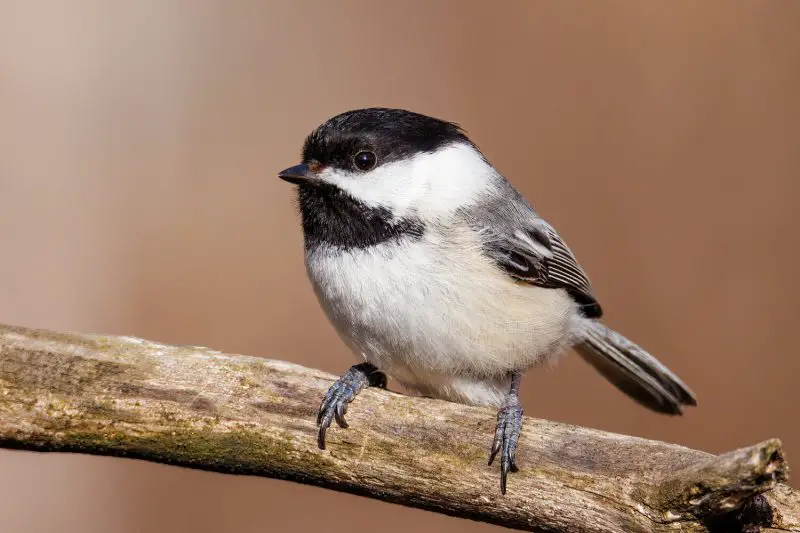If you are interested in birdwatching, Michigan offers a wide variety of black and white birds that bring contrast and beauty to the landscape. From tiny chickadees to striking loons, these species are easy to identify thanks to their bold markings.
Some of them are year-round residents, like woodpeckers and nuthatches, while others, such as gulls, grebes, and warblers, only pass through during migration. This mix of permanent and seasonal species makes birdwatching in Michigan rewarding at any time of year.
Birds with black and white plumage stand out in forests, wetlands, and even suburban backyards. Their unique calls, feeding habits, and striking appearances add to the charm of observing them across the state.
Table of Contents
- 1 Types of Black and White Birds Found in Michigan
- 1.1 Black-capped Chickadee (Poecile atricapillus)
- 1.2 Downy Woodpecker (Dryobates pubescens)
- 1.3 Hairy Woodpecker (Dryobates villosus)
- 1.4 Red-bellied Woodpecker (Melanerpes carolinus)
- 1.5 Northern Flicker (Colaptes auratus)
- 1.6 White-breasted Nuthatch (Sitta carolinensis)
- 1.7 Dark-eyed Junco (Junco hyemalis)
- 1.8 Black-and-white Warbler (Mniotilta varia)
- 1.9 Eastern Kingbird (Tyrannus tyrannus)
- 1.10 Common Loon (Gavia immer)
- 1.11 Ring-billed Gull (Larus delawarensis)
- 1.12 Bonaparte’s Gull (Chroicocephalus philadelphia)
- 1.13 Common Tern (Sterna hirundo)
- 1.14 Horned Grebe (Podiceps auritus)
- 1.15 Pied-billed Grebe (Podilymbus podiceps)
- 2 Best Time and Places to Observe Black and White Birds in Michigan
- 3 FAQs about Black and White Birds in Michigan
Types of Black and White Birds Found in Michigan
Black-capped Chickadee (Poecile atricapillus)
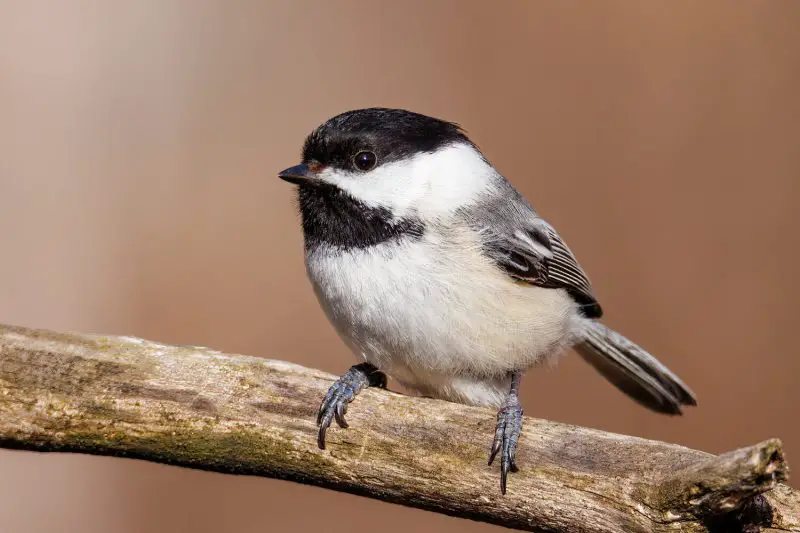
The Black-capped Chickadee is one of the most familiar black and white birds in Michigan, often visiting backyard feeders year-round. This small songbird has a black cap and bib, white cheeks, and soft gray wings. Despite its tiny size, it is hardy and thrives even in Michigan’s cold winters. Its distinctive “chick-a-dee-dee-dee” call makes it easy to identify.
In terms of behavior, chickadees are curious and social, frequently moving in small flocks during the non-breeding season. They often join mixed-species groups with nuthatches and woodpeckers to forage for insects, seeds, and berries. At feeders, they usually grab one seed and fly off to eat or store it.
Their adaptability allows them to live in forests, suburban yards, and even urban parks. They nest in cavities, often using abandoned woodpecker holes or soft decayed wood where they can excavate their own nest site. Both males and females work together to raise their young.
For birdwatchers, winter is one of the best times to see Black-capped Chickadees up close. They readily come to feeders stocked with sunflower seeds, suet, and peanuts. Their bold nature often makes them comfortable feeding near humans, sometimes even from an outstretched hand.
Downy Woodpecker (Dryobates pubescens)
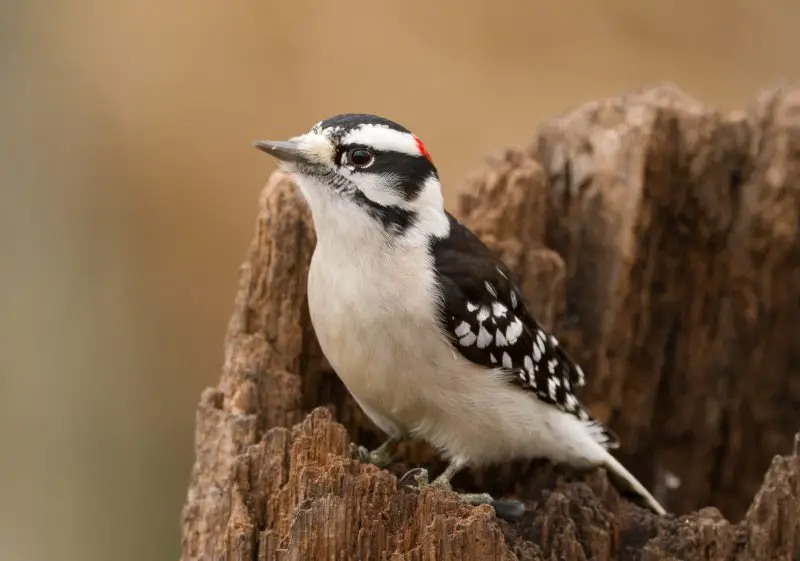
The Downy Woodpecker is the smallest woodpecker species in Michigan, easily recognized by its black and white patterned wings and small size. Males display a tiny red patch on the back of the head, while females lack this marking. Its short bill helps distinguish it from the similar Hairy Woodpecker.
This bird is active year-round in Michigan, where it frequently visits backyard feeders offering suet, peanuts, or sunflower seeds. It is also a common sight clinging to tree trunks and branches while searching for insects, which make up the majority of its diet.
Downy Woodpeckers prefer mixed woodlands, orchards, and suburban areas. They nest in cavities that they carve out themselves in dead or decaying trees. During the breeding season, pairs defend their territory by drumming loudly on resonant surfaces.
Their adaptability and small size make them less shy than larger woodpeckers, often allowing close views for bird enthusiasts. Watching them work methodically along tree bark gives a glimpse into how they play a role in controlling insect populations.
Hairy Woodpecker (Dryobates villosus)
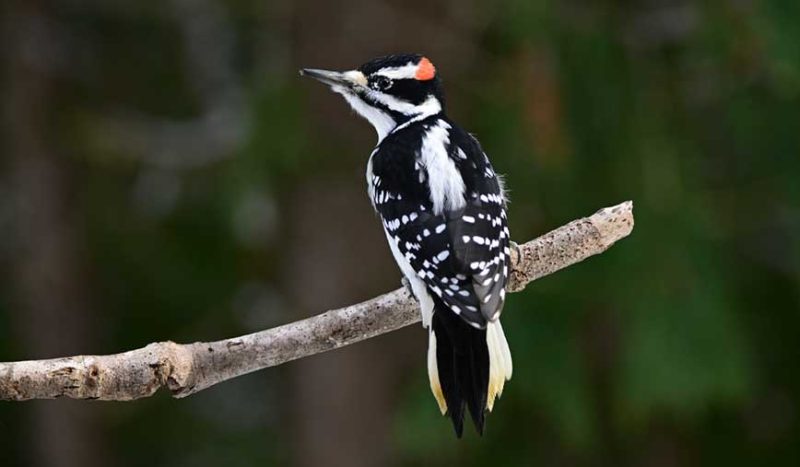
The Hairy Woodpecker looks almost identical to the Downy Woodpecker, but it is larger with a longer, stronger bill. Like the Downy, males have a red patch on the back of the head, while females do not. Their black and white plumage features bold stripes and spots, making them striking against Michigan’s trees.
Hairy Woodpeckers are more often found in mature forests than in suburban areas, though they will visit feeders for suet and seeds. They are efficient hunters of insects, particularly beetle larvae, which they extract from beneath tree bark using their powerful bill.
They are cavity nesters, usually selecting dead trees or limbs for excavation. The male does much of the drilling, while the female helps with nest preparation. Both parents share the responsibility of feeding their young until fledging.
Although less common in backyards than the Downy, the Hairy Woodpecker can still be observed across Michigan throughout the year. Their sharp, quick tapping sounds and strong drumming rhythms help birdwatchers distinguish them from smaller woodpeckers.
Red-bellied Woodpecker (Melanerpes carolinus)
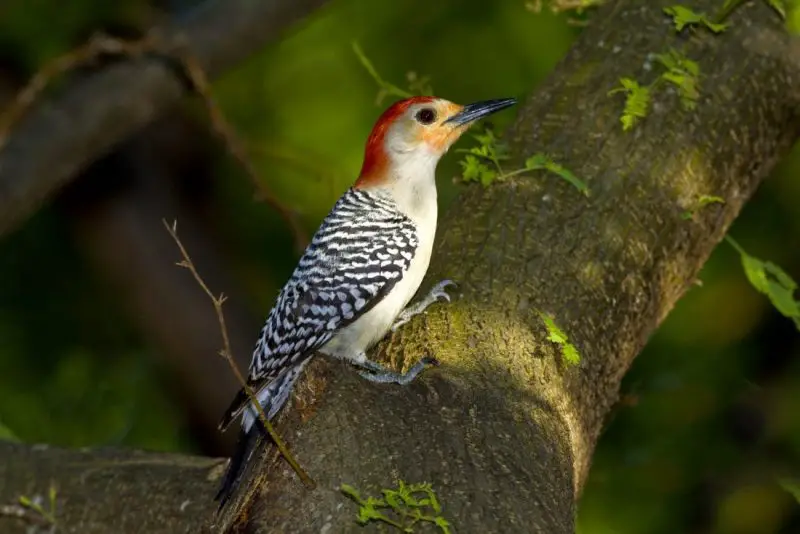
The Red-bellied Woodpecker is a striking bird with black-and-white barred wings and a red cap that extends from its bill to the nape in males. Despite its name, the reddish tinge on its belly is faint and often hard to see. This woodpecker has become increasingly common in Michigan over the past few decades.
They thrive in woodlands, parks, and suburban areas, where they can often be seen clinging to tree trunks. Their diet is varied, including insects, seeds, nuts, fruits, and even occasional small lizards or nestlings. In winter, they eagerly visit feeders that provide suet, sunflower seeds, or peanuts.
These birds are cavity nesters, often using dead trees or limbs to excavate a nesting site. The male begins the excavation, and once the female approves, the pair completes the nest. Both parents participate in raising the chicks, ensuring a high survival rate.
Red-bellied Woodpeckers are bold and vocal, producing a rolling “churr” call that often gives away their presence. Their combination of striking plumage and active behavior makes them a favorite among birdwatchers in Michigan.
Northern Flicker (Colaptes auratus)
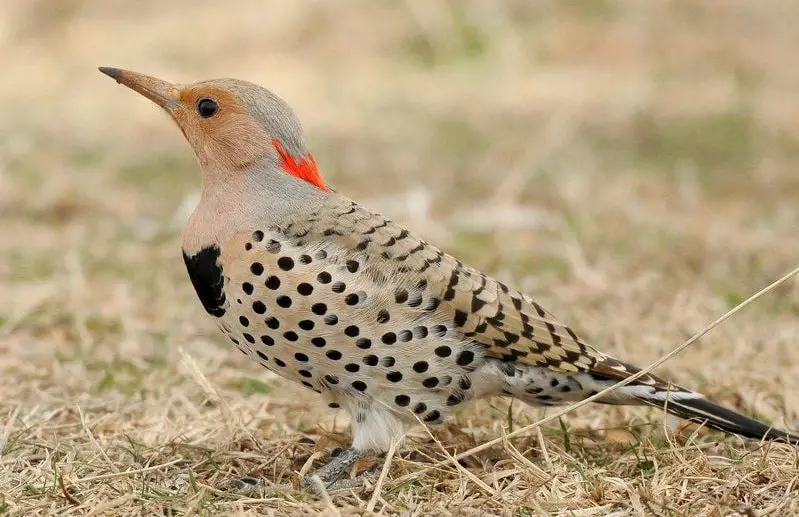
The Northern Flicker is one of Michigan’s most distinctive woodpeckers, easily recognized by its brownish body covered with black spots, a black crescent on the chest, and barred wings. In flight, its white rump and bright yellow wing linings are especially noticeable. Unlike most woodpeckers, flickers are often seen foraging on the ground.
They primarily feed on ants and beetles, using their long, barbed tongues to extract insects from soil and rotting wood. This sets them apart from other woodpeckers, which spend more time hammering on tree bark. However, they will also visit feeders for suet and seeds, especially in winter.
Northern Flickers nest in tree cavities, often in dead or decaying trees, where they excavate their own nesting sites. Both parents share incubation duties and take turns feeding the chicks. Their loud, repeated “wick-a-wick-a-wick” call and rhythmic drumming are common sounds in Michigan forests.
These woodpeckers are migratory, with some leaving Michigan in winter for southern states. However, many remain in the state year-round, especially in areas with reliable food sources. Their ground-feeding habits make them unique and fascinating for bird enthusiasts to observe.
White-breasted Nuthatch (Sitta carolinensis)
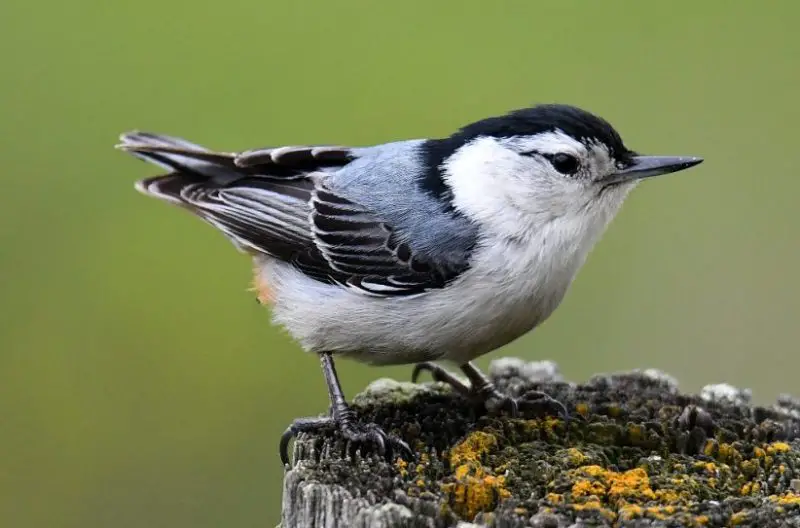
The White-breasted Nuthatch is a compact black, white, and gray bird often seen climbing headfirst down tree trunks. Its striking black cap, white face, and long pointed bill make it easy to identify. In Michigan, it is a common year-round resident, especially in deciduous forests and suburban backyards.
This species has a unique feeding style. Unlike woodpeckers that hammer on bark, the nuthatch creeps along branches and trunks, probing into crevices for insects and seeds. It often wedges large seeds into bark and then hammers them open with its bill. At feeders, it favors sunflower seeds, peanuts, and suet.
During nesting season, pairs select natural tree cavities or abandoned woodpecker holes. They line their nests with soft materials such as bark fibers, hair, and feathers. Both parents work together to raise their young, with the male often feeding the female while she incubates the eggs.
Their nasal, laughing call is a common sound in Michigan’s forests. Bold and active, White-breasted Nuthatches are frequent feeder visitors, and their upside-down foraging behavior adds a lively presence to any birdwatching experience.
Dark-eyed Junco (Junco hyemalis)
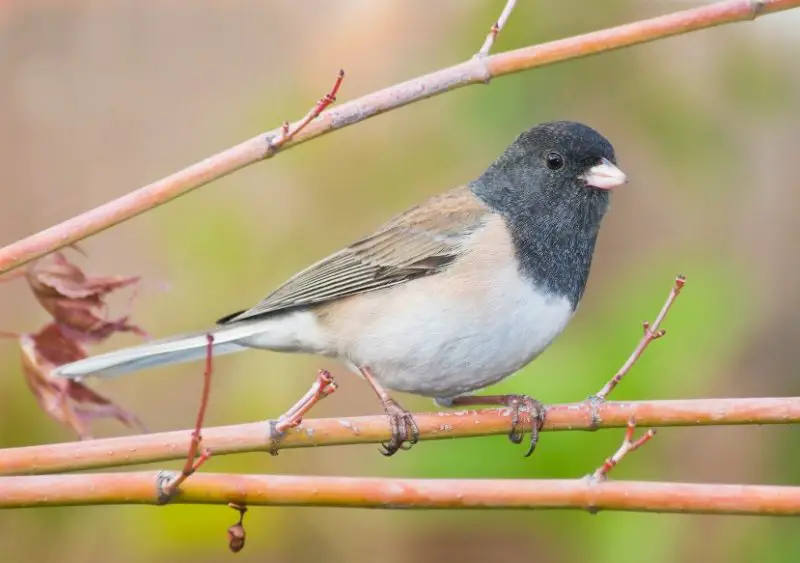
The Dark-eyed Junco is a small, sparrow-like bird with crisp black, gray, and white plumage. Males are usually darker, while females appear more brownish. Its white outer tail feathers flash during flight, helping with identification. These birds are widespread winter visitors across Michigan, often called “snowbirds” because they arrive as cold weather sets in.
Their diet consists mainly of seeds, especially during winter, when they forage on the ground beneath feeders. They also eat insects during the breeding season. Juncos often travel in flocks, hopping about on snowy lawns, fields, and forest edges in search of food.
In summer, most Michigan juncos migrate north to breed in Canada’s boreal forests. However, a few may nest in Michigan’s Upper Peninsula, choosing dense conifer stands or mixed forests. Their nests are usually hidden on the ground, well-camouflaged among roots or fallen branches.
Juncos are shy compared to other feeder birds, but their large winter flocks make them highly noticeable. Their soft trilling songs and “ticking” call notes bring sound and movement to Michigan’s quiet winter landscapes.
Black-and-white Warbler (Mniotilta varia)
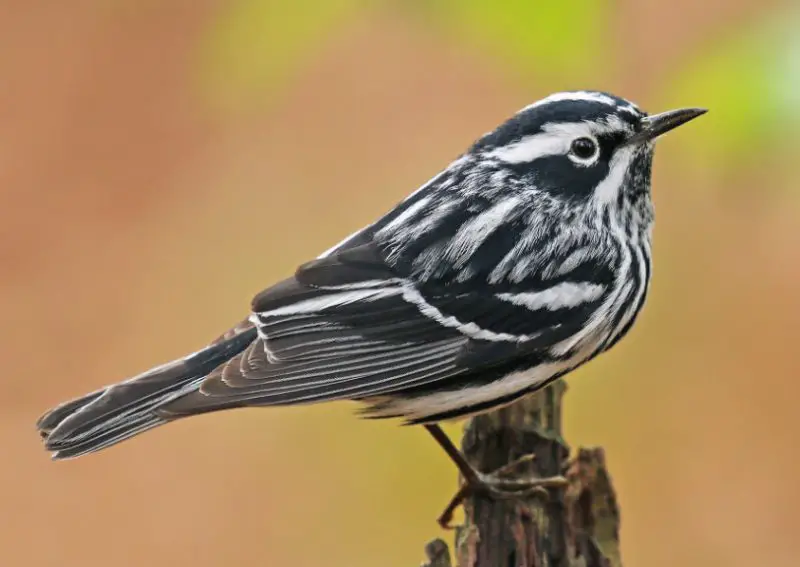
The Black-and-white Warbler is one of Michigan’s more unusual warblers because of its striking zebra-like plumage. Males and females both have bold black-and-white stripes, though males tend to have darker streaks on the face and throat. Unlike most warblers, which flit through foliage, this species creeps along tree trunks like a nuthatch.
They are primarily insect-eaters, using their thin, slightly curved bills to probe into bark crevices for spiders, caterpillars, and beetles. During spring and fall migration, they are common in Michigan’s woodlands, and some remain to breed, especially in northern forests.
Nests are built on the ground, hidden under leaves, tree roots, or logs. The female lays several eggs and incubates them while the male helps defend the territory. Once hatched, both parents feed the chicks with a steady supply of insects until fledging.
For birdwatchers, Black-and-white Warblers are a delight to spot because their foraging style is so different from other warblers. Their high-pitched, squeaky song is another helpful clue to their presence in Michigan’s forests.
Eastern Kingbird (Tyrannus tyrannus)

The Eastern Kingbird is a bold black-and-white flycatcher, instantly recognized by its dark gray to black upperparts, white underparts, and distinct white band at the tip of its tail. Despite its modest size, it has a commanding presence and is often seen perched in open areas such as fields, orchards, and along rivers.
Eastern Kingbirds are insect hunters, catching prey in midair with remarkable agility. They also eat berries, especially later in the summer. Their hunting style involves quick flights from an exposed perch, then returning to the same spot after snatching insects.
Nesting takes place in trees, shrubs, or sometimes on fence posts near open landscapes. The nest is built from twigs and grasses, and both parents aggressively defend their territory. They are fearless in driving away much larger birds, including crows and hawks.
These kingbirds migrate long distances, spending winters in South America. In Michigan, they are most visible during summer, adding lively energy to meadows and farmlands with their sharp “kit-kit” calls and aerial acrobatics.
Common Loon (Gavia immer)
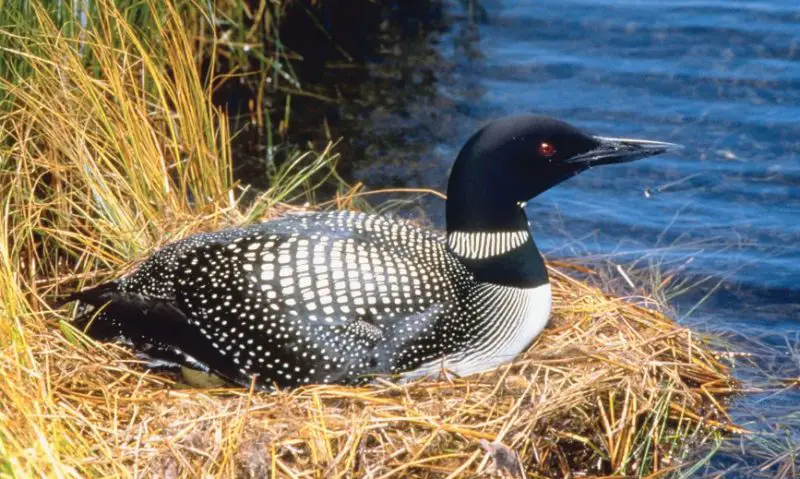
The Common Loon is one of Michigan’s most iconic black-and-white birds, especially known for its haunting, echoing calls across northern lakes. Its breeding plumage is striking, with a black head and neck, red eyes, and a checkered black-and-white back. In winter, it molts into a duller gray-and-white plumage.
Loons are expert divers, perfectly adapted for underwater hunting. Their sharp bills and powerful legs allow them to catch fish, their primary food source. They prefer clear, deep lakes where visibility is high, making them excellent at spotting prey.
Nesting occurs along freshwater lakes in northern Michigan, particularly in the Upper Peninsula. Loons build floating nests near the shore, often hidden among vegetation. Both parents share incubation duties and care for the young, which sometimes ride on their backs for safety.
The eerie calls of loons are a defining sound of Michigan’s wilderness. They serve as territorial signals and communication between mates. For many, hearing a loon’s call is one of the most unforgettable experiences in Michigan’s northwoods.
Ring-billed Gull (Larus delawarensis)
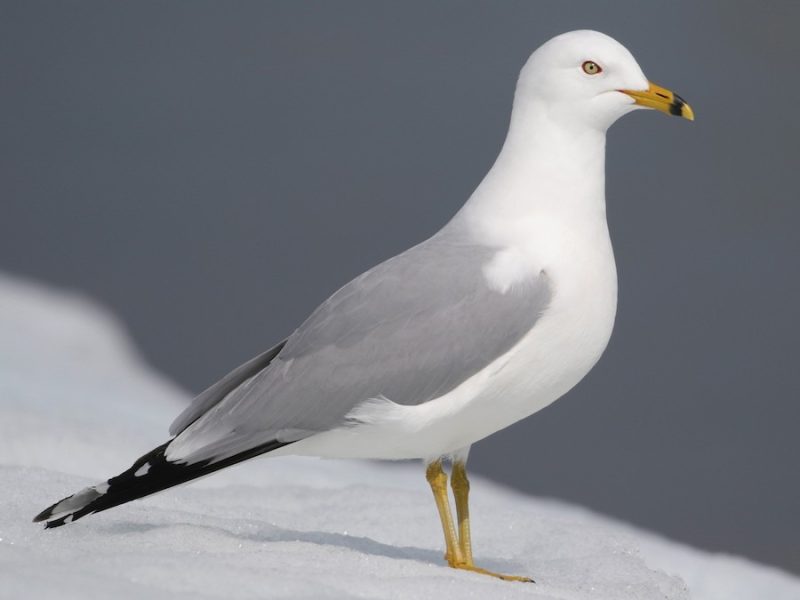
The Ring-billed Gull is one of the most familiar black-and-white birds in Michigan, especially around the Great Lakes. Adults have clean white bodies, light gray wings with black tips, and a distinctive yellow bill marked with a black ring near the tip. Their bright yellow legs and sharp, loud calls make them easy to notice in flocks.
These gulls are opportunistic feeders, eating fish, insects, earthworms, and even human food scraps. They are commonly found in parking lots, landfills, and beaches, where they gather in large numbers to feed. Their adaptability to both natural and urban environments explains their abundance across Michigan.
During nesting season, Ring-billed Gulls form colonies on islands and along shorelines. Nests are shallow scrapes lined with grass, feathers, or other available materials. Both parents share incubation and chick-rearing duties, raising young in noisy, crowded colonies.
For birdwatchers, they may seem ordinary, but their graceful flight and adaptability are remarkable. In migration seasons, thousands can be seen roosting along lakeshores or soaring over Michigan’s rivers and farmlands.
Bonaparte’s Gull (Chroicocephalus philadelphia)

The Bonaparte’s Gull is smaller and more delicate than the Ring-billed Gull, with a striking black head in breeding plumage and a white body accented by pale gray wings. In winter, the black head disappears, leaving only a small dark spot behind each eye. This seasonal transformation makes them interesting to observe.
Unlike many gulls, Bonaparte’s Gulls are graceful fliers, often resembling terns in their movements. They feed mainly on small fish and insects, dipping lightly into the water or catching prey midair. During migration, they can be found along Michigan’s lakeshores, rivers, and wetlands.
They breed far to the north in Canada’s boreal forests, where they uniquely nest in trees instead of on the ground. This makes them unusual among gulls, most of which are ground nesters. They migrate through Michigan in large numbers, especially during spring and fall.
Their small size, buoyant flight, and distinct seasonal plumage make them a favorite among bird enthusiasts. Spotting them alongside larger gulls highlights their elegance and subtle beauty.
Common Tern (Sterna hirundo)

The Common Tern is a slender, black-and-white bird often seen hovering gracefully above Michigan’s lakes and rivers. Adults have pale gray wings, a black cap, red-orange legs, and a sharp bill that is usually tipped in black. In flight, their deeply forked tails give them a graceful appearance.
Terns are expert fish hunters, diving headfirst into the water to catch small fish. They also eat insects and occasionally crustaceans. Unlike gulls, which often scavenge, terns rely almost entirely on live prey, making them more dependent on healthy aquatic habitats.
In Michigan, Common Terns nest in colonies on sandy or rocky islands. Their nests are simple scrapes in the ground, often lined with shells or vegetation. Both parents incubate the eggs and care for the young, defending the colony aggressively from intruders.
Sadly, their populations have declined in parts of the Great Lakes due to habitat loss and human disturbance. Conservation efforts are ongoing to protect their nesting sites and ensure that these elegant birds remain a part of Michigan’s ecosystem.
Horned Grebe (Podiceps auritus)
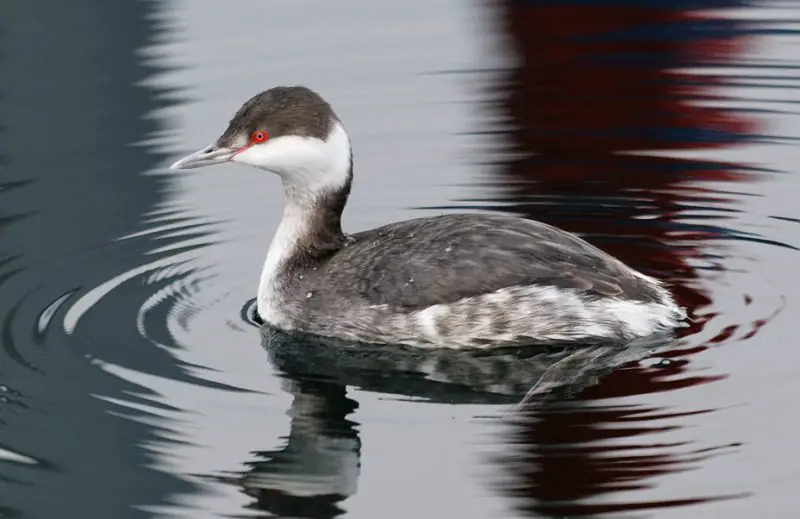
The Horned Grebe is a striking waterbird, best known for its elaborate breeding plumage. During the nesting season, it has a black head, golden “horn-like” feather tufts, and a rich chestnut neck and sides. In winter, it transitions to a more subdued black-and-white appearance, which is often seen in Michigan during migration.
Grebes are diving specialists, using their lobed feet to chase fish and aquatic insects underwater. Their diet also includes crustaceans and small amphibians. They prefer open lakes, ponds, and marshes during migration stops in Michigan.
Breeding occurs farther north, where they build floating nests anchored to reeds or vegetation. Both parents share in nest building, incubation, and feeding of the young. The chicks often ride on their parents’ backs, sheltered under their wings for warmth and protection.
In Michigan, Horned Grebes are most often seen during spring and fall migrations. Their changing plumage and striking courtship displays make them a highlight for birdwatchers lucky enough to encounter them in breeding dress.
Pied-billed Grebe (Podilymbus podiceps)
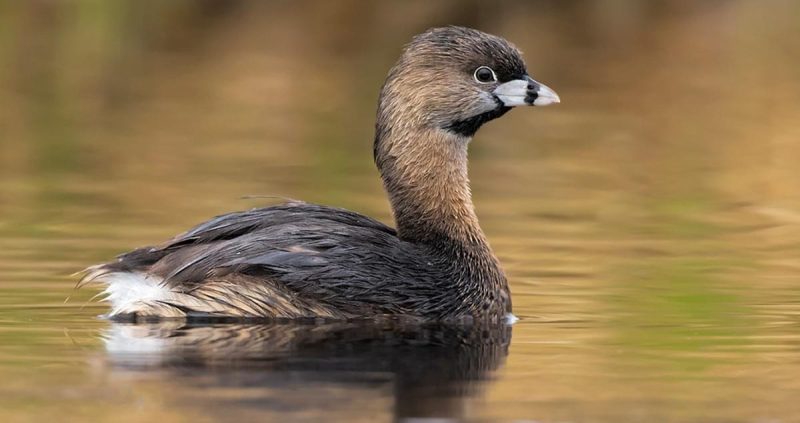
The Pied-billed Grebe is a small, brownish waterbird with a distinctive thick bill marked by a black band during the breeding season. While less boldly black-and-white than some other species, its bill and contrasting plumage patterns make it a recognizable bird across Michigan’s wetlands.
Adapted for diving, Pied-billed Grebes hunt fish, insects, and amphibians underwater. They are shy birds, often diving to escape danger rather than flying away. Their compact bodies and excellent swimming abilities allow them to remain hidden in dense vegetation.
Nesting takes place in marshes and ponds, where they construct floating platforms of reeds and grasses. Both parents are involved in raising the chicks, which, like other grebes, often ride on their parents’ backs for safety in the first weeks after hatching.
In Michigan, they can be found year-round in some areas, though many migrate south in winter. Their soft, gulping calls echo through wetlands, making them easier to detect than to see. Birdwatchers prize sightings of Pied-billed Grebes for their secretive habits and unique behaviors.
Best Time and Places to Observe Black and White Birds in Michigan
Michigan offers a wide variety of habitats, from northern forests to the Great Lakes shoreline, making it an excellent state for observing black and white birds. The best time to see them depends on the species, as some are year-round residents while others only pass through during migration.
Winter is an ideal season for spotting resident birds like Black-capped Chickadees, Downy Woodpeckers, Hairy Woodpeckers, White-breasted Nuthatches, and Dark-eyed Juncos. These species often come to backyard feeders, especially when natural food sources are scarce. Suet, sunflower seeds, and peanuts are reliable attractants that bring them close for easy viewing.
Spring and fall migration are the best times to see species such as Bonaparte’s Gulls, Black-and-white Warblers, and Horned Grebes, which pass through Michigan on their way to breeding or wintering grounds. The Great Lakes shorelines, inland wetlands, and northern woodlands are prime locations for observing these birds in large numbers. Summer is especially good for spotting loons and terns in northern Michigan, where they nest on lakes and islands.
FAQs about Black and White Birds in Michigan
What black and white birds stay in Michigan year-round?
Species like the Black-capped Chickadee, Downy Woodpecker, Hairy Woodpecker, White-breasted Nuthatch, and Red-bellied Woodpecker remain in Michigan throughout the year and are often seen at backyard feeders.
Which black and white birds migrate through Michigan?
Birds such as the Bonaparte’s Gull, Common Tern, Horned Grebe, and Black-and-white Warbler migrate through Michigan, typically seen in spring and fall. The Eastern Kingbird is also a summer migrant, leaving for South America in winter.
Where can I see Common Loons in Michigan?
The Common Loon is best observed in northern Michigan, particularly the Upper Peninsula and northern Lower Peninsula lakes during spring and summer. Their haunting calls echo across remote freshwater lakes.
How can I tell the difference between Downy and Hairy Woodpeckers?
The Hairy Woodpecker is noticeably larger with a longer, more robust bill compared to the Downy Woodpecker. Both species share similar black-and-white markings but differ in size and bill shape.
What should I put in my feeder to attract black and white birds?
Suet, sunflower seeds, and peanuts are excellent choices to attract Downy Woodpeckers, Hairy Woodpeckers, Black-capped Chickadees, and White-breasted Nuthatches. During winter, these foods help sustain birds when insects and natural seeds are scarce.

